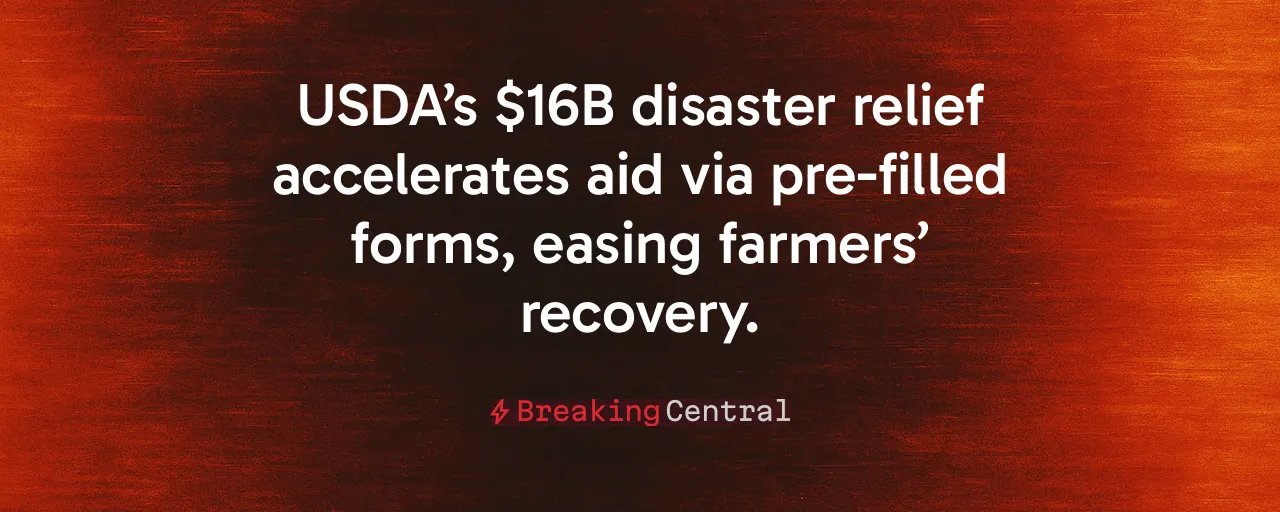A Lifeline for American Farmers
American farmers face relentless challenges from nature’s fury, with wildfires, hurricanes, and droughts devastating crops in 2023 and 2024. On July 9, 2025, the U.S. Department of Agriculture, led by Secretary Brooke L. Rollins, launched a $16 billion Supplemental Disaster Relief Program to support producers who suffered eligible losses. This bold move signals a commitment to rural communities, ensuring farmers can recover and continue feeding the nation.
Unlike past delays, this program delivers aid with urgency. Prefilled applications, mailed the same day as the announcement, allow farmers to apply starting July 10 at local Farm Service Agency offices. The initiative reflects a clear priority: get money into farmers’ hands quickly so they can rebuild without bureaucratic hurdles.
This effort aligns with a broader vision to strengthen agriculture. By tying relief to future crop insurance requirements, the USDA encourages producers to plan for long-term stability. The approach balances immediate help with policies that promote responsibility and resilience.
Cutting Through Red Tape
The USDA’s strategy stands out for its efficiency. Stage One of the program targets farmers already enrolled in crop insurance or the Noninsured Crop Disaster Assistance Program, using existing data to streamline applications. This eliminates unnecessary paperwork and speeds up payments, a stark contrast to the 13- to 19-month delays under the previous administration’s disaster relief efforts.
To ensure fairness, payments are capped at 90 percent of losses, with a flat 35 percent payment factor applied uniformly. This avoids the complex, progressive formulas of past programs that slowed delivery and often favored larger operations. The flat factor simplifies calculations, ensuring small and large producers alike receive timely support.
The program’s design reflects a practical reality: farmers need cash flow to replant, pay vendors, and sustain rural economies. By prioritizing speed and simplicity, the USDA addresses the immediate liquidity crunch that can push farms toward bankruptcy.
Building Resilience for Tomorrow
A key feature of the relief program is its mandate that recipients purchase crop insurance or Noninsured Crop Disaster Assistance Program coverage at a 60 percent level for the next two crop years. This requirement, enforceable with repayment penalties, ensures farmers are better prepared for future disasters. It’s a forward-thinking move that promotes self-reliance over dependence on government aid.
Historical data supports this approach. Studies from the USDA’s Economic Research Service show that farms with consistent crop insurance coverage are less likely to face insolvency after disasters. By linking relief to future risk management, the USDA is fostering a culture of preparedness that benefits both producers and taxpayers.
This policy also responds to the growing frequency of climate-driven disasters. Since the 1980s, ad-hoc disaster aid has evolved from occasional bills to annual programs, with payments averaging over $10 billion since 2017. Requiring insurance helps contain future costs while equipping farmers to handle increasing risks.
Guarding Against Waste and Fraud
With $16 billion at stake, oversight is critical. The USDA’s reliance on verified crop insurance and Noninsured Crop Disaster Assistance Program data minimizes the risk of fraudulent claims. Additionally, the program’s clear eligibility criteria, tied to specific disasters like wildfires, floods, and severe droughts, ensure funds reach those genuinely affected.
However, challenges remain. Four states—Connecticut, Hawaii, Maine, and Massachusetts—opted for separate block grants instead of direct payments, raising concerns about inconsistent aid distribution. The USDA must work closely with these states to prevent mismanagement and ensure farmers receive equivalent support.
Taxpayers also benefit from the program’s fiscal discipline. By capping payments and applying a flat factor, the USDA stretches limited appropriations to cover more producers. This contrasts with calls for permanent, open-ended disaster programs, which could strain budgets without addressing underlying risk management.
A Model for Future Relief
The Supplemental Disaster Relief Program sets a strong precedent. Its rapid rollout, streamlined process, and focus on future preparedness offer a blueprint for effective disaster aid. The USDA’s broader $30 billion portfolio, including $7.8 billion in Emergency Commodity Assistance Program payments and $1 billion for livestock producers, reinforces this commitment to rural America.
Yet, the program isn’t perfect. Stage Two, set for fall 2025, must address uninsured farmers and shallow losses without repeating past delays. Clear communication and adequate staffing at Farm Service Agency offices will be essential to maintain momentum.
Looking ahead, policymakers should build on this model. Expanding state block grant flexibility while setting national standards could balance local needs with equity. Subsidizing crop insurance for small or beginning farmers could further broaden participation, ensuring no producer is left vulnerable.
Standing With Rural America
The USDA’s swift action reflects a deep respect for farmers’ role in sustaining the nation. By delivering $16 billion in relief with minimal bureaucracy, the program stabilizes rural communities, supports jobs, and secures the food supply. Its emphasis on crop insurance lays the groundwork for a more resilient agricultural sector.
Farmers aren’t just recovering; they’re preparing for the future. This balance of immediate aid and long-term planning embodies a practical, principled approach to governance. It prioritizes results over rhetoric, ensuring rural America remains strong.
As the USDA continues to refine its efforts, one thing is clear: when farmers thrive, the nation prospers. This program is a step toward that shared goal, proving that targeted, efficient relief can make a lasting difference.
